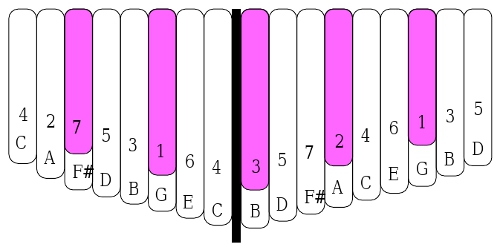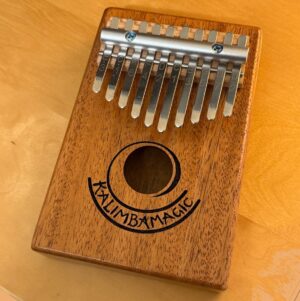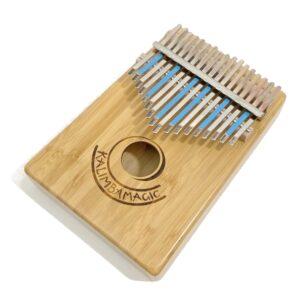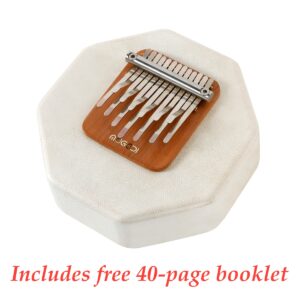“I Can See Clearly” by Johnny Nash.
Yes, yes, I could have played this on a Hugh Tracey Chromatic Kalimba. But instead, I take the easy way out, using three diatonic kalimbas instead.
Diatonic Scale, Diatonic Kalimba
If you don’t know the word “diatonic”, learn it! It describes a kalimba that has only notes from some major scale: “Do Re Mi Fa So La Ti Do…” It could have 8 notes, 10, or 17 notes… but the notes are all in one particular key, such as C or G. And it will have all of those notes in that key, over some particular range. As you go to higher octaves, you stay within the key the lower octave has set out. The low note of a diatonic kalimba doesn’t need to be the “Do”. And there are no extra notes, such as a minor 3rd or a flat 7.
If your diatonic kalimba is in the key of C, it has all the white notes on some range of the piano, and no black notes. But the Alto kalimba is a diatonic kalimba in G. It has F# tines, but skips the white-note F natural.
A lot of music is fully diatonic. You can play the entire melody with just the diatonic notes on your kalimba. And often, you can play the entire harmony with that same diatonic kalimba. A diatonic kalimba doesn’t get you anywhere near 50% of the music that is possible with all the notes, but a diatonic kalimba will probably permit you to play way more than 50% of the songs that you know.
As songs and harmonies become more complicated, like Jazz or Classical music, you need other notes. And here is a little trick I have to get those other notes.
The 17-Note Kalimba in C
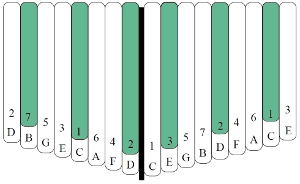 I Can See Clearly by Johnny Nash is a perfect example of a song that needs more notes. The first three lines of the song can be played on the 17-Note Kalimba in C. In particular, the line “I can see all obstacles IN my way” plays the note “B” on the word IN.
I Can See Clearly by Johnny Nash is a perfect example of a song that needs more notes. The first three lines of the song can be played on the 17-Note Kalimba in C. In particular, the line “I can see all obstacles IN my way” plays the note “B” on the word IN.
But we cannot play the entire melody of the verse on this kalimba, because there is an accidental in the melody. An accidental is a note that is just outside of the scale. A non-diatonic note. A Bb (B flat, or a half step lower than the B natural) is required, and it isn’t on your kalimba.
There are some things you can do. You could retune the B to a Bb on the fly – which is really a bit crazy unless you have like 10-20 seconds in the song where other people are covering for you and you don’t have to play anything. You could get a little disk magnet and put it on your B tine to make a Bb. (You will have to know how bag a magnet, and where on the B tine you need to put it to make your Bb.) You could play this song on a Chromatic Kalimba. Or, you could do a trick like I do.
The Bb Treble Kalimba
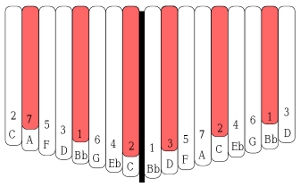 The melody has the Bb accidental on the refrain, “It’s gonna be a BRIGHT, bright sun-shiney day”, and you can actually play that on Bb Treble Kalimba. You should be able to hear that the note of BRIGHT is a bit odd or unexpected. The expectation for a B natural has already been established on “IN my way”.
The melody has the Bb accidental on the refrain, “It’s gonna be a BRIGHT, bright sun-shiney day”, and you can actually play that on Bb Treble Kalimba. You should be able to hear that the note of BRIGHT is a bit odd or unexpected. The expectation for a B natural has already been established on “IN my way”.
About the Bb Treble Kalimba tuning and setup: The tines are painted the same way as the 17-Note Kalimba in C (with the 6-tine painting system). The entire kalimba is tuned a whole step lower than the C kalimba. You can see me playing the C, the painted tine in the middle of the right side, at the end of the verse, on the second “sun-shiney DAY“.
And then, we modulate into the bridge. You can hear the Bb kalimba walk up from C, to D, to Eb on the right side. This is a bit shocking, because the scale has already been firmly established to have an E natural, the major 3rd of C. You can see me sneaking in an E natural with my right index finger in between the two “bright sun-shiney day” lines. I wanted that major 3rd in the chord, but it isn’t on this kalimba, so I had to borrow it from one of the other kalimbas.
While the vocal part of the bridge can be played completely on this Bb kalimba, what comes next requires more notes still!
